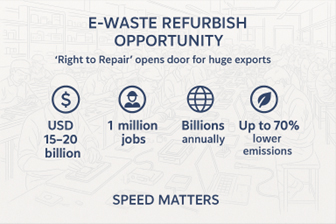



Billions in exports, a million jobs, and a greener future—lost to delay
By Ravishankar Kalyanasundaram
Earlier this year, India celebrated becoming the second-largest mobile manufacturing nation in the world, assembling more than 330 million handsets annually. At the same time, the country generated 3.2 million tonnes of e-waste, of which less than 20 percent is formally recycled.
The contrast is stark because the global economy is moving in exactly the opposite direction. The European Union’s new “Right to Repair” law compels manufacturers to supply spare parts, extend warranties, and promote repair over replacement. As companies scramble for low-cost hubs to handle this new demand, Poland—a country that barely figured on the electronics map a decade ago—has surged ahead. By creating repair-friendly customs rules and vocational training programmes, Poland has become a prime mover, hosting Apple, Dell, and HP repair centres and already earning billions of dollars annually.
India, with its abundant discarded electronics and vast youth workforce, should have been the natural leader. Instead, the opportunity is drifting abroad. And with it, jobs, investments, exports—and a greener way of dealing with our own waste—slip away.
The Global Push Towards Repair
The numbers reveal the scale. The global electronics repair and refurbish industry is projected to exceed USD 100 billion by 2030. The economics are simple: repairing a laptop motherboard or refurbishing a smartphone costs a fraction of producing a new one, while cutting carbon emissions by up to 70 percent.
Countries that acted quickly now reap the rewards. Malaysia allows used devices into bonded free zones for repair and re-export. Dubai channels Gulf e-waste into refurbish parks that feed Africa. Poland, almost from scratch, now anchors Europe’s after-sales supply chain. Speed of policy, not cost advantage, made the difference.
India’s Paradox
India is the third-largest e-waste generator in the world, after China and the US. It has millions of semi-skilled young people who could be trained for electronics repair. Informal repair shops already thrive in every Indian town.
Yet policy remains stuck. Used electronics are still treated largely as “hazardous waste,” rather than as raw material for a new industry. Containers carrying faulty components routinely get stranded at ports. Announced projects—such as Tamil Nadu’s proposed e-waste cluster near Chennai or Karnataka’s park in Dobaspet—remain on paper.
India has the waste, the skills, and the market. What it lacks is immediacy.
The Untapped Skill of Our Youth
Anyone who has walked through Delhi’s Nehru Place or Chennai’s Ritchie Street knows the truth: India’s youth are already masters of repair. In tiny kiosks and roadside stalls, they replace cracked screens, recover lost data, and revive “dead” laptops with astonishing ingenuity. These micro-enterprises show what is possible when skill meets need—even without policy support.
Now imagine scaling that energy into export-oriented repair zones in SEZs and port cities. Instead of chasing overseas jobs or waiting endlessly for H1-B visas, young Indians could service the world’s gadgets right here at home. Every refurbished laptop exported to Europe or Africa would mean not just a dollar earned but a livelihood created in India. This is one global market where we already have the skills; all we need is the green light.
Lost Opportunities, Real Costs
Inaction is not abstract; it has a price tag.
Each lost contract means thousands of jobs and millions in export earnings diverted abroad.
Poland Shows What’s Possible
The sharpest contrast is Poland. A decade ago, it played no role in electronics repair. But when the EU tightened e-waste rules, Warsaw responded with clarity and speed: tax incentives, customs exemptions, and vocational training.
Today, Polish facilities service global brands for all of Europe. The sector employs tens of thousands of technicians and generates billions in exports. What Poland achieved through immediacy, India forfeited through delay.
India’s Potential
Harnessing even half of our e-waste formally would transform the landscape:
This is not theory. These numbers are drawn from global practice. The only missing ingredient is urgency.
What India Should Do—Now
The Bigger Picture
India is rightly proud of its smartphone manufacturing boom. But the electronics economy does not end at the assembly line. Repair, refurbish, and recycle are the natural second chapters—industries that are more job-intensive, more climate-friendly, and more export-oriented.
Without speed, India risks being an assembler of new devices and a dumping ground for old ones. With speed, it can dominate the entire lifecycle of electronics.
Closing Reflection
India has learnt to announce reforms with flourish. But in the global economy of tomorrow, speed is the true currency. Every month of delay costs us contracts, jobs, and credibility.
Electronics repair may lack the glamour of AI or green hydrogen. Yet it is precisely the kind of industry that can absorb our youth, build exports, and serve the planet. The skills already exist in every street-corner shop. What is missing is the policy green light to scale them up into billion-dollar export industries.
This is one opportunity where jobs, dollars, investment, and sustainability all align. To ignore it would be unforgivable.
No, we can’t miss it.